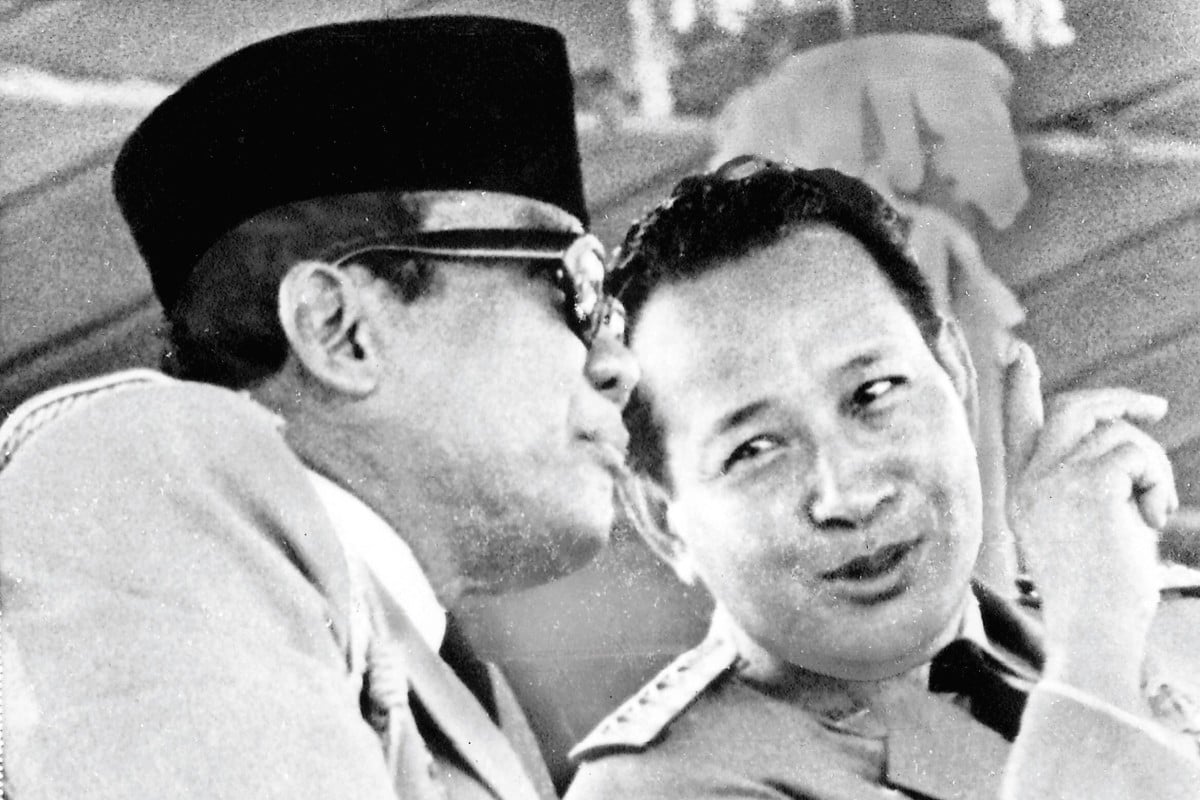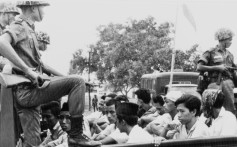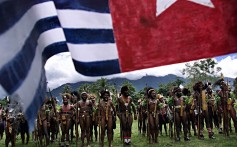Review | Sukarno, Suharto, and the US-backed mass murder of communists in Indonesia that set the template for Cold War regime change worldwide
Slaughter in Indonesia in 1965 set template for the systematic mass murder of civilians in the name of anticommunism, Vincent Bevins says in The Jakarta Method
‘This was one of the most important turning points of the 20th century, eliminating the largest communist party outside China and the Soviet Union,’ he writes
Kit Gillet Published: 28 Jun, 2020

Indonesian president Sukarno (left), who handed over his presidential power to military strongman Suharto in February 1967, is shown with Suharto during an Independence Day Parade in Jakarta, in October 1966. Photo: AP
The Jakarta Method by Vincent Bevins, PublicAffairs. 3/5 stars
In 1965, the Indonesian military killed as many as one million of their own countrymen, destroying the third-largest communist party in the world and taking with it pretty much anyone seen as having left-wing tendencies (as well as hundreds of thousands who had nothing to do with anything).
Not many people were killed in the streets or officially executed, but rather disappeared into the night.
On the island of Bali, at least 5 per cent of the population, about 80,000 people, were killed, but even today, the events of 1965 are little known outside Indonesia, or even within it.
“For more than 50 years, the Indonesian government has resisted any attempt to go out and record what happened, and no one around the world has much cared to ask, either,” writes journalist Vincent Bevins in The Jakarta Method: Washington’s Anticommunist Crusade and the Mass Murder Program that Shaped Our World. The book attempts to lift the veil while also putting the bloody events in a global context and pointing an accusatory finger at the United States.

In many ways the violence was a result of actions by the American government and the CIA, which during the Cold War used any means possible to stop the spread of communism. This often involved installing friendly right-wing strongmen in countries around the world, even if it meant overturning democratic processes and being complicit in acts of brutality.
Indonesia in 1965 wasn’t the first time the US government got involved in overthrowing an elected government, or the last, but it would be highly consequential.
“This was one of the most important turning points of the 20th century, eliminating the largest communist party outside China and the Soviet Union and inspiring copycat terror programmes in faraway countries like Brazil and Chile,” writes Bevins.
Between 1945 and 1990, a loose network of US-backed anti-communist extermination programmes carried out mass murder in at least 22 countries, and these groups often learned from one another, adopting methods developed in other countries. Some used the term “Jakarta”, harking back to events in Indonesia.
America has come to terms with Indonesia’s past. Why can’t Indonesians?
29 Oct 2017

Like many countries during this period, Indonesia, a parliamentary democracy and the world’s fourth most-populous country, had tried to remain neutral, engaging and often receiving aid from both the US and the Soviet Union. However, under president Dwight D. Eisenhower, the US began to take a more aggressive approach to deciding if and when an independent nation had become insufficiently anti-communist, writes Bevins. Indonesia and its playboy president, Sukarno, increasingly came under the microscope.
Bevins, a Southeast Asia correspondent for The Washington Post and previously the Brazil correspondent for the Los Angeles Times, has created a powerful record of the often-muddled events in Indonesia following a botched coup on September 30, 1965, which was blamed on communist forces.
The book covers the appearance and rise of military strongman General Suharto, who was considered friendly to US interests and would go on to rule the country until 1998.
“Everything Suharto did in October [1965] suggests that he was executing an anti-communist counter-attack plan that had been developed in advance, not simply reacting to events,” writes Bevins, who adds that Washington quickly began to supply communication equipment to the army and made it clear that direct assistance could resume if the local communist party was destroyed, the president removed, and attacks on US investments stopped
Most disturbing, the US embassy prepared lists of the names of thousands of communists and suspected communists, “and handed them over to the army, so that these people could be murdered and ‘checked off’ the list”. One embassy worker reportedly said that he “probably has a lot of blood on my hands, but that’s not all bad”. Managers of US-owned plantations also furnished the names of “troublesome” communists and union organisers, who were subsequently killed
Meanwhile, American publications and journalists parroted the official line, even as rumours of widespread violence circulated and a further million citizens were herded into concentration camps.
Perhaps not surprisingly, it worked. “Almost overnight the Indonesian government went from being a fierce voice for Cold War neutrality and anti-imperialism to a quiet, compliant partner of the US world order,” historian John Roosa is quoted as saying.
“I came to the conclusion that the entire world, and especially the countries of Asia, Africa, and Latin America … has been reshaped by the waves emanating from Brazil and Indonesia in 1964 and 1965.”Vincent Bevins writes in The Jakarta Method
While Indonesia is a focus of the book, the narrative stretches far beyond the country’s borders, detailing CIA-backed regime changes across vast swathes of the world.
Bevins suggests the US-backed dictatorship in Brazil, which took power in a coup in 1964, played a crucial role in pushing the rest of South America into the anti-communist group of nations. “I came to the conclusion that the entire world, and especially the countries of Asia, Africa, and Latin America, … has been reshaped by the waves emanating from Brazil and Indonesia in 1964 and 1965,” he writes. These two events “led to the creation of a monstrous international network of extermination – that is, the systematic mass murder of civilians – across many more countries”.
Communist parties elsewhere could not fail to take note, with some adopting a more militant attitude perhaps in response to the right-wing threat.
The Jakarta Method offers an easily digestible chronology of this bloody period of Indonesian and world history. While at times the narrative can be too systematic, and lacking in prose that would bring it more to life, the result is a powerful reminder that in many countries around the world, the Cold War was anything but cold, and those that suffered the most were often ordinary people.
In one of the most revealing passages of the book, Bevins describes how eyewitnesses and victims, all these years later, talk about that period in terms of weeks, specific dates, hours, even minutes. The trauma and suffering are still raw, made worse by a lack of public discussion and closure.
As much as the brutal methods were abhorrent, Bevins admits they were effective. “I am not saying that the United States won the Cold War because of mass murder,” he writes, but adds that the extermination programmes in countries such as Indonesia, “organised and justified by anti-communist principles”, was such an important part of the US victory that the violence profoundly shaped the world we live in today.
It is a sobering thought.
Read more
“Everything Suharto did in October [1965] suggests that he was executing an anti-communist counter-attack plan that had been developed in advance, not simply reacting to events,” writes Bevins, who adds that Washington quickly began to supply communication equipment to the army and made it clear that direct assistance could resume if the local communist party was destroyed, the president removed, and attacks on US investments stopped
Most disturbing, the US embassy prepared lists of the names of thousands of communists and suspected communists, “and handed them over to the army, so that these people could be murdered and ‘checked off’ the list”. One embassy worker reportedly said that he “probably has a lot of blood on my hands, but that’s not all bad”. Managers of US-owned plantations also furnished the names of “troublesome” communists and union organisers, who were subsequently killed
Meanwhile, American publications and journalists parroted the official line, even as rumours of widespread violence circulated and a further million citizens were herded into concentration camps.
Perhaps not surprisingly, it worked. “Almost overnight the Indonesian government went from being a fierce voice for Cold War neutrality and anti-imperialism to a quiet, compliant partner of the US world order,” historian John Roosa is quoted as saying.
“I came to the conclusion that the entire world, and especially the countries of Asia, Africa, and Latin America … has been reshaped by the waves emanating from Brazil and Indonesia in 1964 and 1965.”Vincent Bevins writes in The Jakarta Method
While Indonesia is a focus of the book, the narrative stretches far beyond the country’s borders, detailing CIA-backed regime changes across vast swathes of the world.
Bevins suggests the US-backed dictatorship in Brazil, which took power in a coup in 1964, played a crucial role in pushing the rest of South America into the anti-communist group of nations. “I came to the conclusion that the entire world, and especially the countries of Asia, Africa, and Latin America, … has been reshaped by the waves emanating from Brazil and Indonesia in 1964 and 1965,” he writes. These two events “led to the creation of a monstrous international network of extermination – that is, the systematic mass murder of civilians – across many more countries”.
Communist parties elsewhere could not fail to take note, with some adopting a more militant attitude perhaps in response to the right-wing threat.
The Jakarta Method offers an easily digestible chronology of this bloody period of Indonesian and world history. While at times the narrative can be too systematic, and lacking in prose that would bring it more to life, the result is a powerful reminder that in many countries around the world, the Cold War was anything but cold, and those that suffered the most were often ordinary people.
In one of the most revealing passages of the book, Bevins describes how eyewitnesses and victims, all these years later, talk about that period in terms of weeks, specific dates, hours, even minutes. The trauma and suffering are still raw, made worse by a lack of public discussion and closure.
As much as the brutal methods were abhorrent, Bevins admits they were effective. “I am not saying that the United States won the Cold War because of mass murder,” he writes, but adds that the extermination programmes in countries such as Indonesia, “organised and justified by anti-communist principles”, was such an important part of the US victory that the violence profoundly shaped the world we live in today.
It is a sobering thought.
Read more

No comments:
Post a Comment